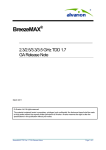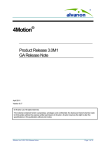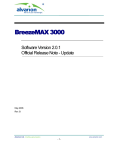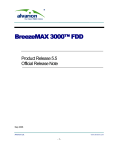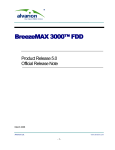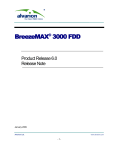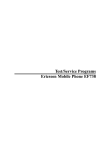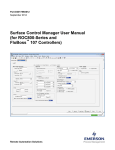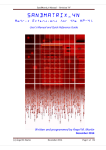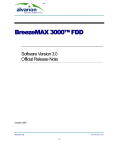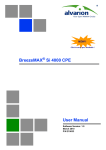Download Release Notes
Transcript
BreezeMAX® Micro Base Station 2.3/2.5/3.3/3.5/3.65 GHz TDD GA Release Note March 2011 © Alvarion Ltd. All rights reserved. The material contained herein is proprietary, privileged, and confidential. No disclosure thereof shall be made to third parties without the express written permission of Alvarion. Alvarion reserves the right to alter the specifications in this publication without prior notice. BreezeMAX TDD Micro Base Station Ver.1.7 Release Notes Page 1 of 5 General This document details the main hardware elements and software features, known problems and limitations of the BreezeMAX Micro Base Station, of release 1.7 version. The Product Released The product released here is based on the BreezeMAX systems released in release 1.5, working in bands 2.3GHz, 2.5GHz, 3.3GHz and 3.5GHz TDD and intended for the worldwide use. This version supports all software features from previous TDD versions (1.5) The software in release 1.7 (software version 4.7) can be operable on the already released hardware equipment of release 1.5. The Micro Base station has small dimensions with all Base Station required components: NPU, AU Power Supply and Power Interface as described in the specifications. Changes from 4.5 GA Version The software package for the 4.7 software version consists of Micro BST SW Version 4.7.0.151 and SU SW version 4.7.0.151. This software package brings the following features: Hardware • New ODU working in 2340-2400Mhz • New all-outdoor GPS product by Alvarion, which can be used with Release 1.7 or higher only. Software New functionalities: • QinQ feature. The system supports the 802.1 QinQ standard, which defines the way to have 2 VLAN tags (double-tagged frames). • Adding 4 new 2.3GHz ODU IDs in the NPU frequency band files as follows: o ODU ID 10 2.3WCS o ODU ID 11 2.3ROW band A o ODU ID 12 2.3WCS o ODU ID 40 2.3ROW bandB These new IDs are replacing the unique ODU ID 12 available for the 2.3GHz frequency range in previous releases. BreezeMAX TDD Micro Base Station Ver.1.7 Release Notes Page 2 of 5 Note: Prior to performing a software upgrade, customers operating in 2.3 GHz frequency band have to disable all ODUs, then, upgrade system software and define the right ODU types before enabling the ODUs. If the software upgrade steps mentioned before are not completed correctly, an ODU mismatch message will be displayed after software upgrade completion, and the ODU state will be down. Removed Functionality: • Removed Managed VoIP services. Documentation There are two major independent manuals, the Base Station System Manual and the CPEs Product Manual. Each manual covers all relevant topics associated with the respective equipment, including: • Product / system description • System installation • Commissioning • Operation and administration. The documentation includes the following: • BreezeMAX Modular Base Station TDD System Manual • BreezeMAX Micro Base Station TDD System Manual and Addendum for Ver.1.7 • BreezeMAX CPEs TDD Product Manual • BreezeMAX TDD Troubleshooting Guide • BreezeMAX TDD Traps and Alarms • BreezeMAX Base Station Installation & Maintenance Manual. This manual contains an appendix for the “H” mounting bracket installation guidelines • BreezeMAX PRO CPE Installation Manual • AlvariCRAFT User Manual • BreezeMAX Service Manager • WiMAX Modem Application Operator Manual • Smart Card Writer/Reader Application User Manual • Quick Installation Guidelines o GPS Quick Installation Guide o Preparing the IDU-ODU GPS Cable o Si CPE Quick Installation Guide o CPE Quick Installation Guide o New SAU Quick Installation Guide o SAU Extension Cable Quick Installation Guide o “H” Mounting Bracket Quick Installation Guide for Monopole o “H” Mounting Bracket Quick Installation Guide for Mast o “H” Mounting Bracket Quick Installation Guide for Tower BreezeMAX TDD Micro Base Station Ver.1.7 Release Notes Page 3 of 5 Known Problems and Known Limitations 1. After a GPS receiver replacement, the NPU must be reset. 2. The management port is for local management only. The management port may only be used when the network is different from the data port (i.e. another router interface). This is to prevent using the same physical router MAC address for both data and management ports. 3. In a system with a great number of connections, in case of heavy traffic, real-time QoS malfunctions while service type is being changed. 4. In scenarios of very heavy traffic and large point-to-multipoint configuration, the AU resets may occur. 5. When changing from diversity mode to no diversity and vice versa, the AU channel must be enabled manually after changing to diversity mode. 6. AU reset when transmitting overload broadcast frames of 64 bytes. 7. Software download to BreezeMAX CPEs may fail when uplink traffic is higher than 2.5Mbps. 8. SNMP IfOutDiscards and ifInDiscards counters present inaccurate information. 9. Alvarion’s Voice Gateway requires working in transparent VLAN mode, in order to avoid problems that may arise while working with enabled Hybrid VLAN mode on one of the services passing through the VG. 10. There is a 30-second waiting period before the AU admin status can be changed from enable to disable. 11. Smart-Card application does not support windows Millennium and 98 operating systems. 12. The Ethernet port configuration is removed from the list of fields that are read from the Smart-Card by the CPE, as of version 4.1. This still appears in the Smart Card Application file for backward compatibility (version 4.0.2). 13. It is mandatory to reset the CPE after changing the CPE password or username. 14. Low System Utilization in uplink causes increased jitter and latency in the uplink. 15. It is not possible to configure CIR = 0 via SNMP. 16. When WiMAX Modem Application is running on a PC, it is mandatory to stop any TFTP Server application that is running on the same PC. 17. When the system is overloaded, CPEs may not succeed in joining fragmented packets, causing increased packet loss. 18. In rare cases, in scenarios of very heavy traffic and large point-to-multipoint configuration, it may not be possible to change the classification configuration in the service. 19. When an ODU is connected, the AU accepts configuration of frequency, although the actual ODU has a different band. 20. Before deleting a service, the operator should first disable the service in order to update the Multicast connection. 21. Before disconnecting an IF or RF cable from the ODU, the channel should be disabled (stop – 48VDC) 22. When working in bi-directional mode in point-to-multipoint at heavy traffic of short packet, there might be throughput degradation. 23. SAU LEDs do not work properly in cases of heavy traffic. BreezeMAX TDD Micro Base Station Ver.1.7 Release Notes Page 4 of 5 24. The new AU-ODU RF heads (2.3/2.5) are ready to operate in 10MHz. These AU-ODUs can be identified via the NPU. The new AU-ODUs HC08 revision is 137 while the previous AU-ODU was 134. When an old AU-ODU (pre-beta release 08/06) is replaced with a new AU-ODU and vice versa, the AU IDU must be reset. The Tx power range of the new AU-ODUs is between 30-36 dBm, and not 25-36 as on previous AU-ODUs. If the output power of a new AU-ODU is configured to 25-29dBm, it will actually transmit 30dBm. Note: In cases of 2nd or 4th order diversity configuration, it is prohibited to mix different types of AU-ODUs (HC08 revision 137 & 134) on the same AU-IDU. This means that in 2nd or 4th order diversity configuration, all the ODUs connected to the AU should be of the same type. 25. In extreme cases, when in low modulation, very high traffic of big packet size and many CPEs working concurrently, latency may exceed 70ms. 26. When there is a communication error with the GPS, the BTS will continue to transmit after the holdover timeout has passed. 27. Service Manager: When two CPEs have the same name but differ in lower or upper case, the service manager rejects the second username, due to a duplication problem. 28. When using the RADIUS service, while the Voice Service Profile (Voice Gateway) is changed in the RADIUS, the VG can lose registration with the network. This requires an SU reset. 29. When configuring a CPE channel through the NPU configuration menu, it does not block setting BW which are not supported on CPE (1.75 MHz, 7 MHz). A trap is generated to indicate the configuration mismatch and the CPE will not apply the change. 30. The configuration for the Spectrum analyzer and mobility features are not accessible through web. 31. When working with access VLAN it is recommended to work with the hybrid mode on. 32. When performing SW download to the uBST, the first TFTP session can succeed if the system disk has enough memory space. If not, then it will fail. During this time, the shadow version will be erased and the operator should initiate another TFTP session. 33. GPS Chaining: When the Master uBST resets, the 1st uBST Slave will switch to Internal and after the reset of the Master finishes, the 1st Slave will switch back to External. This is causing the SUs associated with the 1st Slave to lose connectivity. 34. Provisioning of filtering rules in the uBST TDD should be limited to 10 rules for L2 and L3/L4 each in order to reduce the low performance problems. 35. In loaded sectors, under heavy traffic, sporadic AU PMTM data loss may occur. 36. For multi-product environment consisting of both 4Motion and BreezeMAX TDD products, additional IOT tests are required for the NMS solution provided by Alvarion. Please check the NMS release notes to see what 4Motion and BMAX TDD Software versions are supported. BreezeMAX TDD Micro Base Station Ver.1.7 Release Notes Page 5 of 5





